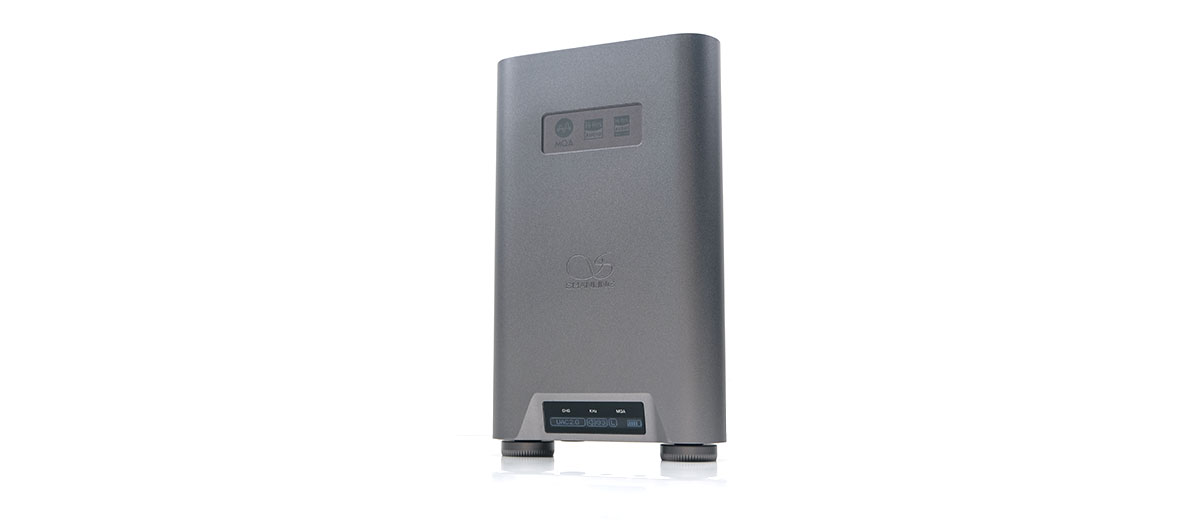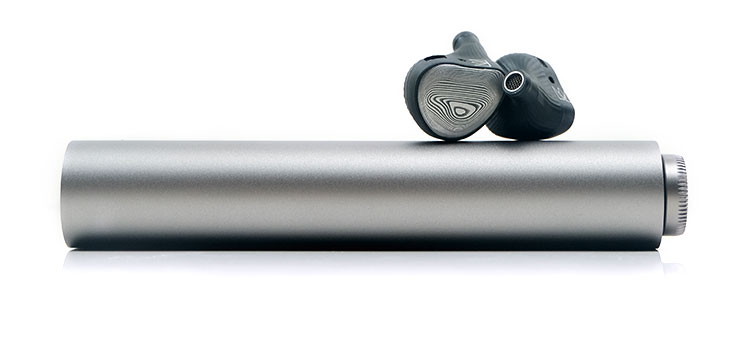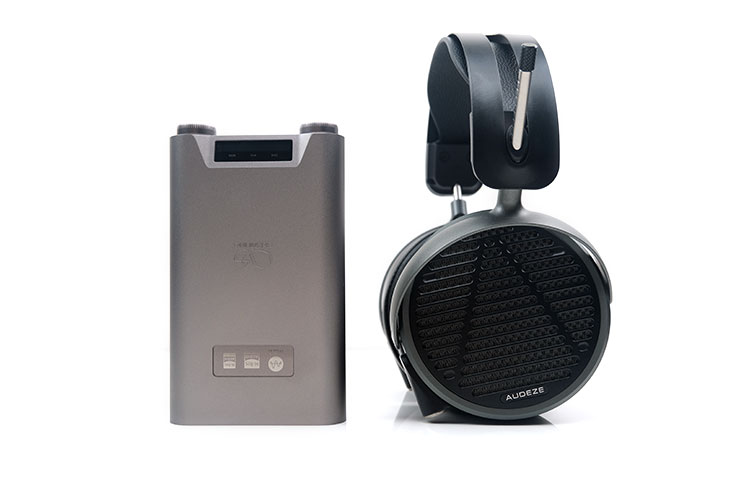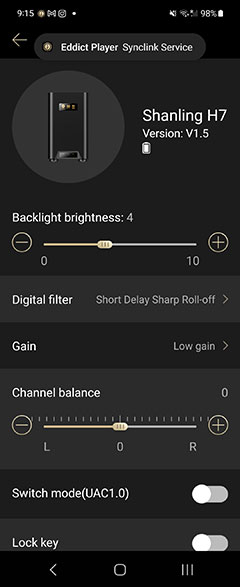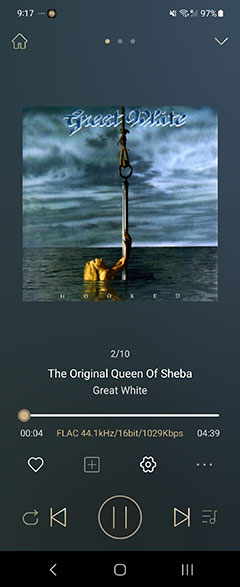Sound Impressions
Summary
The Shanling H7 is the smoother-sounding alternative DAC/Amp to the bludgeoning Q7 power game. It delivers a natural and easier-on-the-ear tonal quality with a perfectly black background that pairs beautifully with clean and resolving sounding headgear.
That is not to say this is a decidedly warm-sounding DAC/Amp, in fact, Shanling owners might classify the H7 as being closer to neutral when compared to their high-end DAPs such as the M8.
However, in the context of something like the Chord Electronics Mojo 2 and the FiiO Q7, it’s definitely more relaxed in its delivery. Particularly on the low end which offers up a bit more bloom in the mid-to-upper bass and a more euphonic overtone in the upper mids of most tested monitor pairings.
Compared to the Q7, it’s the more natural sounding by far for percussion and vocal timbre, though, of the compared DAC/Amps, it’s perhaps the least punchy sounding on the lows.
Local playback and the USB-DAC modes are preferred over the OTG wired connection, as is balanced over unbalanced. In both instances, the amount of useable volume and dynamic range subjectively improved with the possibility of the smartphone 3rd party USB driver being the bottleneck from our tested platforms.
In the case of the stronger balanced output, the delivery was excellent with the moderate loads such as the Audeze MM-500 and Meze Audio’s Elite being ideal pairings in terms of being driven well and having an excellent tonal synergy through the mids and the highs.
Sensitive IEMs such as CA’s Solaris SE will have no issues either with the H7 offering a pitch-black background and excellent low-volume channel balance. Top-tier monitors such as the Viking Ragnar which requires careful matching also benefit from a sweeter more liquid treble coloration from the H7 pairing.
Timbre
The H7 delivers a neutral to natural coloration with a slightly softish attack that hits just right for cleaner-sounding monitors where brighter sources can often tip them into an edgier presentation.
It’s not a lush tone but neither is it an aggressive and bright sound signature either. I had mentioned relaxed but I think that’s more due to the slightly liquid leading edges when compared to the much harder-toned and drier sound of the Q7.
Even compared to the Mojo 2, the H7 sounds a slightly warmer and more elegant presentation, not quite as punchy on the mid-bass impact but more organic and euphonic through the mids timbre, in particular female vocal and percussion performances.
Note weight and density coming from our paired monitors were excellent. The low end of the H7 delivers some excellent body and never seems to leave any paired monitor short of sub-bass presence and rumble.
If there is one observation it’s the comparative softness compared to more neutral DAC/Amps such as the Q7 and Mojo 2 with darker-sounding monitors. IEMs such as the JH Audio Jolene need more of an upper mids and vocal lift which the H7 tends to shy away from. The sound is graceful and slightly sweet rather than upfront and vivid sounding.
That’s not a criticism of the tonal quality of the H7, rather it’s more suited to calming down peppy upper mids and treble performances than exacerbating them.
Staging & Dynamics
The dynamic range and expansiveness of the H7 are excellent. I would say both the staging width and depth are very impressive when paired with open-sounding monitors. It certainly felt like the Viking Ragnar pairing was very filled in with some beautiful peripheral imaging and a very black background.
The Ragnar is a huge sounding monitor but if the sound is too dry and edgy on the treble your ear is going to drift upwards in an unnatural manner. With the H7 the focus for me was more on the mids and the staging width which is where I prefer any good performance to sit.
Not that there was insufficient headroom, there really was tons of extension but rather it’s not forced sounding or bearing down on the midrange timbre creating an unpleasant or digital/dry tonal quality.
Percussion notes and high-pitch synth notes felt natural in terms of tone and positioning with the Ragnar, and the Odin also for that matter also which is typically quite strong for pinna gain and vocal performance.
There is no shortage of density and weight on the very lowest register but it’s more of a neutral imaging position than an intimate and thrusting type of bass response. It’s not quite as punchy and forward on the mid-bass and vocals as the likes of the Mojo 2 or the Q7.
Synergy
Efficiency
The Shanling H7 is a very IEM-friendly portable DAC/Amp, even when using its balanced output which has a much higher output rating compared to the SE.
You will get a very black background with almost no perceived hiss with sensitive IEMs such as the Campfire Audio Solaris SE and the Andromeda 2020. Not just in low gain either but also in medium and high gain. All three levels have impressive noise control on low loads with an excellent channel balance on very low volumes.
Both the balanced and unbalanced PO outputs on the H7 are rated under 1Ω which means there should be no issue with any potential impedance skew when paired with sensitive IEMs.
I would still push you toward the 4.4mm output of the H7 if you have the required cable for most IEMs’ even if you have a very sensitive IEM. The black background combined with the lift in power gives most pairings a bit of a lift in dynamic range and improves the low-end response on our tested IEMs such as the two mentioned above.
IEM Pairings
I felt the Shanling H7 paired best with dynamic and clean-sounding monitors rather than darker alternatives. It also does especially well with IEMs with a strong level of pinna gain in the mids also where you might want to soften the impact of any heavy treble overtones or overt sibilance.
For example, the Campfire Audio Solaris SE has an elevated low-end with that dynamic driver as well as an elevated 1-3k midrange tuning.
The H7 injects some warmth and a slightly liquid edge to the upper mids timbre, including higher pitching vocals. You could argue it’s not as fatiguing as something like the FiiO Q7 which slams harder but also sounds a lot brighter on the upper mids.
The same could be said for the Empire Ears Odin though the H7’s more relaxed low-end tuning means its dynamic driver slam is not quite as evident as the Q7 or as punch as the Chord Electronics Mojo 2. Instead, you get a more natural timbre in the upper mids with less of a spikey lower treble overtone.
I have to say also I did enjoy the H7 pairing with the Noble Audio Viking Ragnar. The Ragnar requires a bit of effort to get the right tonal balance for its EST highs. The H7 works its magic really well there sounding a lot more natural to my ear compared to the FiiO Q7 colder treble.
I was not so keen on the darker-sounding JH Audio Jolene pairing. It just felt too relaxed through the mids and highs though the bass response was good. It needs a more aggressive upper-mids and treble response which is where something like the Mojo 2.s more neutral and intimate tuning takes precedence.
Power
I much preferred the balanced output of the H7 over its SE performance. The overall sound signature in SE felt a little on the soft and relaxed side as opposed to the more energetic and dynamic-sounding balanced output.
Even with sensitive IEMs, you can work your way up the gain levels without too much concern about useable volume levels being reduced dramatically or detectable hiss. In fact, with some monitors, the medium gain setting sounded a lot more vibrant than the smoother but more balanced tone of the low gain balanced output.
Of course, going balanced gets you 1.3W on tap on moderate loads and it does work quite well with headphones such as the Audeze MM-500 as well as Meze Audio’s Elite and the Empyrean.
Of those three, I would bias toward the MM-500 and the Elite. These are quite lively and cleaner sounding than the Empyrean which gelled perfectly with the smoother tone of the H7 stock sound in balanced high gain mode.
HIFIMAN’s HE1000 V2 did ok also in terms of pleasing coloration but personally, I would want a little more power and snap on the low-end. Less efficient headphones such as the Abyss Headphones Diana TC also sounded a little too polite and dynamically soft for a convincing pairing also.
Wireless Performance
Bluetooth Audio
The LDAC performance is very good but there is a distinct difference between it and the local TF card mode and the USB-DAC mode. For a start, the bass has a bit more bloom in BT mode and slightly less treble extension and shine.
Going wired, the H7 sounds a little more neutral or cleaner sounding in its coloration with a tighter snappier bass response and a stronger treble presence and headroom.
In turn, the imaging is just a little more centered in BT mode and not quite as complex sounding whereas wired will sound the more expansive and holographic of the two performances.
Eddict App Performance
Pairing
It’s probably important to start this rundown of the Eddict app by ensuring you have the latest version installed. I had the penultimate version initially on a Samsung Z Flip 3 and it had a difficult time connecting to the H7 via its BT SyncLink feature without crashing.
Once I had V2.1.5 of the Eddict app installed it was pretty much flawless in terms of navigation and pairing with the H7 via SyncLink.
One thing to note when pairing though is do not start by pairing the H7 via a traditional BT mode on your source. Rather keep it in local playback mode if you want access to those files via SyncLink.
The H7 Synclink is, by default, an always-on feature, so the Eddict app will find it and initiate a SyncLink pairing but will not if already paired in BT mode, (status is ‘connection failed’).
Features
Since Eddict acts like a central app for a lot of Shanling’s products some of the features are disabled by default such as WiFi and NAS since there is no WiFi capability inside the H7.
Once you SyncLink you are limited to scanning for music off the H7 local memory card storage and from there navigation, playlisting, and playback of said tracks via its built-in media manager.
The media manager works in a fairly familiar manner with breakdowns for songs, artists, and albums. You also get the ability to work your way through the physical folders or pick out specific tracks with hi-res sampling rates.
Since firmware V1.5 it is possible to draw the tagged artwork from the memory card via SyncLink. That’s a big leap from the previous version 1.4 which never worked for me for artwork.
The one minor problem is the artwork in the main media manager. It only seems to work when in playback mode of the individual tracks or the playback screen and not in the main media manager screen for the album listings.
I tested the latest version on 3 different platforms: Harmony OS, Android, and iOS. All 3 worked seamlessly with the Eddict app using Synclink though iOS has yet to get that recent artwork retrieval ability from firmware V1.5.
That means you are stuck with the older stock Shanling tone arm image for your album covers during playback until Shanling can also find a way to update for iOS.
Wired Connectivity
USB-OTG
The H7 works with just about any OTG-compliant platform out there though for iOS you do need that custom Lightning to USB-C cable for compatibility.
I actually started out using the Shanling H7 like any normal modern DAC/Amp via OTG mode. However, as time went on I felt the onboard playback performance was superior for both volume control and to a lesser extent, overall dynamic range.
For example, using HiBy Music on a Samsung Z Flip 3 and its ‘Exclusive HQ USB Audio Access’ mode forced me to turn the volume up much higher in all gain modes compared to using the H7 local playback option without any wired link-up.
The dynamics from the onboard storage playback mode also felt slightly weightier on the low-end and more vivid through the mids compared to the OTG performance. I suspect the USB driver used by Samsung might be the bottleneck here.
Of course, this may well be anecdotal to my particular smartphone but given you have microSD cards up to the same size as most smartphone memory capacity I would recommend you go the local playback route and use the latest Eddict player version as your GUI.
USB-DAC
The Shanling H7 is plug-and-play with any Windows format that uses the universal 2.0 driver but if you want ASIO capability then you need to download and install the specific USB driver provided by Shanling on their website, (V5.20 at the time of writing).
Once loaded, then everything up to DSD512 is fair game as you can see from the provided picture above.
Using the USB-DAC output you get the same excellent volume headroom and dynamic range from the H7 as the local TF card mode provides which just doubles down on my suspicion that the smartphone USB drivers available to me were not as capable.

